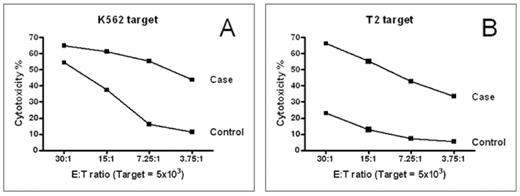Abstract
Dasatinib, a dual tyrosine kinase inhibitor, is known to modulate or suppress T-cell activation and proliferation. We report a series of patients of chronic peripheral lymphocytosis development, identified as natural killer (NK) cells or NK/T-cells based on their large granular lymphocyte (LGL) morphologies and CD16+CD56+CD3− or CD3+ immunophenotypic profiles during dasatinib therapy. All cases that developed LGL lymphocytosis achieved optimal molecular response (8/8 in LGL+ patients vs 3/10 in LGL− patients, p=0.002). A 51Cr release assay demonstrated that NK cell cytotoxicity has been enhanced in a case of LGL lymphocytosis compared to normal healthy donors (Figure 1), and that NK cell cytotoxicity in dasatinib-responders was superior to that in non-responders (Figure 2). In summary, the present study suggests that NK or NK/T cell lineage LGL lymphocytosis develops associated with dasatinib therapy and that LGL might have a therapeutic effect on Ph+ leukemic cells.
Cytotoxicity of NK cells isolated from the patients developing large granular lymphocytosis following dasatinib therapy as assessed by 51Cr release assays using target cells as K562 (A) and T2 cell line (B) as target cells.
Cytotoxicity of NK cells isolated from the patients developing large granular lymphocytosis following dasatinib therapy as assessed by 51Cr release assays using target cells as K562 (A) and T2 cell line (B) as target cells.
The result of 51Cr release assays comparing cytotoxicity of NK cells isolated from patients responding to dasatinib therapy (responder) and not responding (non-responder) following dasatinib therapy using K562 cell line as target cells.
The result of 51Cr release assays comparing cytotoxicity of NK cells isolated from patients responding to dasatinib therapy (responder) and not responding (non-responder) following dasatinib therapy using K562 cell line as target cells.
Disclosures: No relevant conflicts of interest to declare.
Author notes
Corresponding author



This feature is available to Subscribers Only
Sign In or Create an Account Close Modal